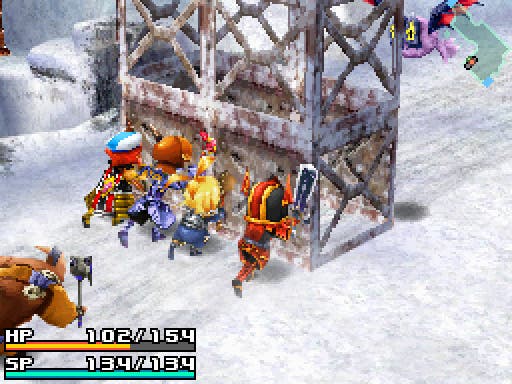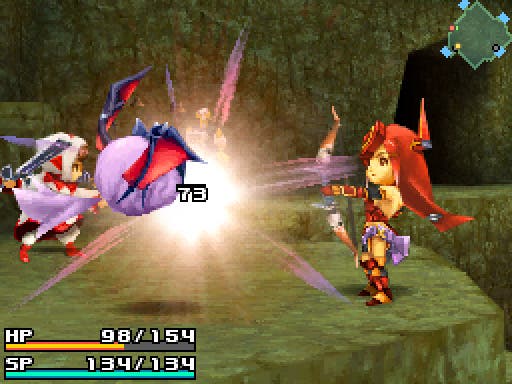Final Fantasy: Crystal Chronicles - Ring of Fates
Fated to repeat old mistakes.
It's ancient history now, but it's amusing to recall the sheer excitement that greeted the announcement that Square was working on a Final Fantasy game for the GameCube. At last, the fans rejoiced, the prodigal was returning - the local boy made good coming home, and surely, surely, signalling a new golden age for Nintendo in the process? Well...
When Final Fantasy: Crystal Chronicles arrived, it was a very different beast to the main FF "number series", and proved divisive. Cute, action-focused and fairly distinctly aimed at a younger (or, at least, non-teenaged) audience, its biggest sin in the eyes of many was that it tried too hard to take advantage of the Cube's possibilities - and, in the process, was seen as taking advantage of gamers' hard-pressed wallets. A primarily multiplayer experience, a proper session required that you have two or three friends around, all with their own Game Boy Advance, and with a link cable for each GBA as well.
In the end we loved the game, but we can certainly see how those who don't have any friends (or, at least, any friends who like cute RPGs and own GBAs) could have despised it. Perhaps as a consequence, the excitement around the new Crystal Chronicles game on the DS has been rather muted - but without the need for multiple GBAs, link cables and all that nonsense, does the game deserve more love this time around?
Artificial Stupidity

In terms of its style and presentation, there's no doubt that Ring of Fates is a fairly direct successor to the original Crystal Chronicles. The cute, "chibi" character designs remain, and the four main races from the original make a reappearance. The single-player game is relatively straightforward action-RPG fare, with a few of CC's unique twists applied to the game mechanics, while the multiplayer is basically the same levels and foes, but designed for up to four players on local Wi-Fi.
In single-player, the game tells a standard JRPG story about a pair of twins who possess the power to activate the eponymous crystals - and who, unsurprisingly, need to trawl through loads of dungeons on the way. You don't actually control both twins - the male twin, Yuri, is the only on-screen character, with his sister only appearing during cut-scenes and dialogue sequences. However, along the way you'll pick up three companions, who can be controlled directly (you switch characters by tapping their icon on the lower screen) or left for the AI to handle.
In theory, this works very well - and, to be fair, for the most part it works very well in practice too. The game promises a fairly solid and entertaining action-RPG experience, and it delivers on that promise. The problem is that all too often, it brings you crashing back down to earth with an unpleasant reminder that this is a game designed as a multiplayer experience - with the ability to play on your own not exactly an afterthought, but certainly second fiddle to the multiplayer.

So, for instance, there's that AI - the AI which controls the three team-mates you're not directly moving around at the time. It is, not to put too fine a point on it, absolutely bloody rubbish. Not even "oh come on, why aren't you healing me?" rubbish - we're talking "oh come on, can't you even walk across a bridge without falling off?" rubbish. "On come on, for god's sake, there's an enemy standing next to you urinating in your astonished face, couldn't you try hitting them back?" rubbish. This, friends, is the kind of rubbish you have to pay your council extra to take away.
To the game's credit, the structure of the gameplay - which essentially sees you moving from room to room and clearing out all the enemies, and allows you to directly control your team-mates with ease - helps to minimise the frustration caused by this weak AI. But it does definitely detract from the experience. So, too, do a number of other problems - for instance, the extreme difficulty of using combo magic in single-player, which is a doddle when playing with friends. Combos require casting multiple spells on the same spot on the screen; easy with friends, since you all target and release at once, but on your own, the chances are a monster will have moved somewhere else by the time you can stack up all the spells.
These problems are a real shame, because they simply wouldn't be that hard to fix had a little more attention been paid to the single-player. However, it's worth re-emphasising that these are not deal-breaking flaws. The core of the combat system remains fast-paced, responsive and most of all, varied. Standard melee, ranged and magic attacks are complemented by the ability to grab enemies and either damage them while they're incapacitated, or smash them into walls - and the ability to throw items around the play area contributes to the hugely enjoyable mayhem of the game.








